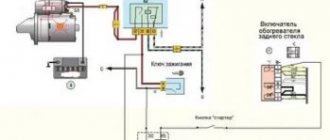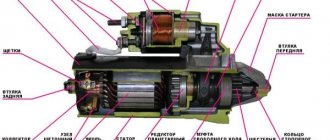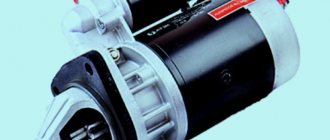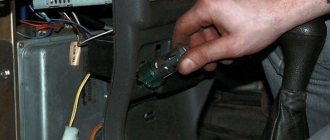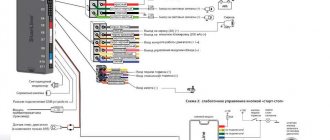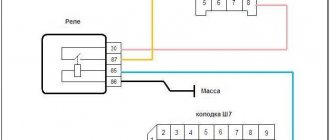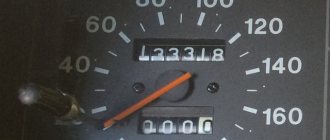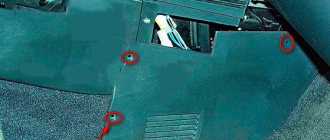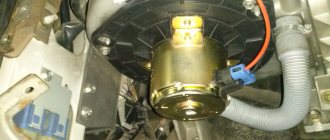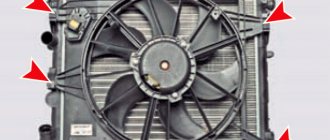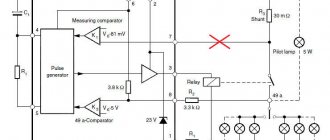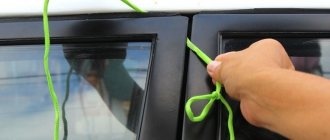Nothing brought early cars closer to mass appeal than the invention of the electric starter: the starting handle was both inconvenient and unsafe. Over more than a hundred years of use, the design of automobile starters has been “polished” almost perfectly, but even now it causes problems. The most typical of them is clicking noises under the hood when starting the engine, but the starter does not turn the engine.
Starter design
Regardless of the specific design (geared/gearless, with or without a stator winding), the electric starter includes a solenoid relay. This electromechanical unit performs two functions simultaneously:
- It pushes the bendix and drive gear forward, allowing it to mesh with the flywheel ring gear.
- It relieves the load on the ignition switch contacts: the current consumed by the starter is large, and the solenoid relay allows you to control the starter using a relatively small current.
The design of the solenoid relay is simple: its body houses two windings of different power, which draw in (hence the name) the core. A fork is installed on the core, which moves the bendix through a lever, and at the end of the stroke the core closes power contacts (“nickels”) that supply power to the starter directly from the battery. Two windings are used to reduce current consumption: more force is required to retract the core than to hold it in place. As soon as the core of the pull-in relay closes the “nickels”, the pull-in winding is bypassed, and only the holding winding works.
Wiring
Often the reason for difficulty starting is related to switching or, simply, wiring. As you know, the connection diagram at this point in the car system is not particularly complicated - the positive terminal of the battery is connected to the VRS (starter), and the negative terminal goes to the body. The starting wire is installed with a small cross-section, conducted from a standard relay controlled by the ignition switch (IZ).
If the relay clicks when starting, but the starter does not rotate, then the “culprit” is the wiring, or the reason must be looked for in the closing device itself. To make sure what exactly is causing the malfunction, you should apply a plus to the starter control.
This is done like this: the ignition is turned on (half a turn), plus power is placed on the control terminal of the starter, where the wiring from the relay is also connected.
- As soon as the starter starts to rotate, then the reason is clearly in the wiring, the closing device or the circuit breaker.
- And if it is motionless, then the reason lies in the starter or something else.
This method of starting the engine is often carried out by experienced vehicle drivers. The method makes it possible to start the internal combustion engine if the road cruise cannot be canceled. But this option should only be carried out with the clutch disconnected. In other words, the transmission must be in neutral, otherwise the car may unexpectedly move forward or backward for the driver.
Starter wiring
Switching always implies the presence of contacts, and they tend to oxidize or not be securely fixed. It is imperative to check all connections, especially if characteristic sounds (clicking or not clicking) occur during the engine startup process. It is especially important to check the condition of the power cable, which directly affects the flow of current.
As you know, despite the functionality and compactness of modern starters, they consume quite a lot of energy. About 200 A is what the starter battery needs to operate. This means that if there is a weak contact anywhere in the wiring, a leak will certainly occur. Of the 200 amperes allocated to the starter, it will reach about 10, which is clearly not enough to crank the device.
Attention. However, for the operation of the VRS, even less amperes are enough. So it turns out that the traction gear engages (clicks), but the starter does nothing.
You should check, as mentioned, all connections, including the battery terminals. The places where the wires are connected should be thoroughly cleaned of oxides, and the areas should also be lubricated with a special compound to avoid a recurrence of the situation. Tightening must be carried out with the torque recommended by the manufacturer.
Causes of clicking noises when starting the engine, checking and solving the problem
Solenoid relay malfunctions
Thus, it is not difficult to think of reasons why the click of the retractor relay may not be accompanied by activation of the starter. The simplest of them is power problems: dead battery, oxidized terminals. At the moment when the solenoid relay turns on the starter winding, a sharp drop in voltage occurs, and with it, in strict accordance with Ohm’s law, the current in the holding winding. The energy of the magnetic field is no longer enough to counteract the retractor return spring, and the core moves outward, breaking the starter circuit. Depending on the condition of the car and the battery, this results in either a single click from the starter or a “machine-gun burst” of clicks from under the hood.
Therefore, the first thing you should check is the battery charge, inspect the terminals on the battery and, if necessary, clean them. Having already guaranteed the supply of electricity “as intended,” we proceed to further verification.
Why does the starter click but not turn over?
The reasons for the failure may differ for each case. No specialized education is required to identify a malfunction. The motorist can independently carry out diagnostic measures. There are several reasons why when you turn the key in the lock, the starter clicks but does not turn.
Accumulator battery
If the on-board network voltage is insufficient, the electric motor cannot turn the flywheel, so the starter clicks but does not turn. In this case, electric current is supplied to the coils of the solenoid relay. Under the influence of an electromagnetic field, the core closes the contacts and a sound signal is heard.
You can check the performance of the battery without using a special tester. In some cars, manufacturers install devices that indicate the voltage of the on-board network. If there is no such device, you can check the battery by turning on the headlights, sound signal, etc.
Oxidation at the battery terminals leads to a voltage drop in the on-board network. To eliminate the malfunction, it is necessary to clean the contact surfaces and connect the terminals. A low supply voltage may be a sign of battery failure.
Power circuit
If the integrity of the wire is broken, no voltage is supplied to the electric motor, so the starter does not turn. The fact that it clicks indicates that the intermediate relay is activated. You should look for a wire break in the circuit of the control positive contact connected to the solenoid relay (SR).
You can identify it without using a multimeter. It is necessary to apply a voltage corresponding to the standard to the control contact BP. If the starter clicks and turns, electric current is supplied to the contact pad of the intermediate relay, etc.
In this way, you can determine in which part of the circuit the break is located. To eliminate the malfunction, replace the failed wire with a known working one. It is important to take into account its cross-section.
Solenoid relay
The design of the unit provides for the presence of 2 windings - retracting and holding.
Under the influence of an electromagnetic field, the metal core closes the contacts. This is how electric current is supplied to the electric motor. The other side of the core engages the drive gear in mesh with the flywheel. A malfunction, manifested by the fact that the starter clicks but does not turn, occurs as a result of:
- Oxidation of contacts (nickels). Upon contact and separation, carbon deposits form on the surface of the contact pads, which accumulates over time. This prevents the electric starter from starting properly.
- Winding breakage. The metal core does not move. In this case, clicks are heard only from the intermediate relay.
If the windings break, a complete replacement of the VR will be required. Oxidation of the pads is eliminated by cleaning and polishing or installing new ones. In the process of cleaning the sites yourself, the outer layer, which is resistant to soot, is damaged. This method allows you to restore the functionality of the node for a short time. It is better to install new nickels so that in the near future you will not again encounter the fact that the starter clicks but does not turn.
Electrical engine
A breakdown of the electric starter motor makes it impossible to start the power unit. When you turn the key in the ignition switch, supply voltage is supplied to the electric motor, but the armature does not start rotating. This causes the starter to click but not turn.
You can check the performance of the electric motor without removing the starter from its seat. There are 2 bolts visible at the end of the solenoid relay. They are connected to each other with a metal object. In this case, metal objects are applied to the ends of the bolts. Failure to follow this rule may result in damage to the threads.
When touched, the anchor should begin to rotate. In this case, the drive gear (Bendix) does not engage with the flywheel. The electric motor is idling.
It is forbidden to connect the contacts with a wire with a small cross-section. When exposed to high current, the temperature of the wire will rise sharply, which may cause fire or burns.
There are 3 reasons why the anchor does not start rotating:
- Failure of the brush assembly. To start the car engine, a commutator-type electric motor is used. The voltage is transmitted to the armature using graphite brushes. Wear of one or more brushes leads to malfunctions.
- In some cases, the brushes become jammed in the guide shaft. The starter clicks but does not turn. To eliminate the malfunction, the brushes should be replaced and the shafts should be cleaned of dirt.
- Broken stator or armature winding. Due to the lack of an electromagnetic field, it is impossible to start the engine. To resolve the problem, it may be necessary to replace the faulty part.
- Bushing wear. The armature rotates freely on the bushings. They are made from soft metal alloys. If the bushings are heavily worn, the rotor warps in relation to the stator, and normal operation of the starter becomes impossible. For repairs it is necessary to replace the bushings.
To restore the functionality of the unit and eliminate the reason that the starter clicks but does not turn, it is necessary to remove it from the car. This can be done either by contacting a car repair shop or by yourself.
Signaling
One of the reasons why the starter does not turn, although it clicks, is a third-party alarm. Modern security systems block the launch. To diagnose a breakdown, turn off the alarm and restart the engine. The shutdown method varies depending on the type of security system.
Mechanical problems
Rarely on cars with high mileage is it possible for the Bendix to simply stick into the crown tooth. Initially, both the flywheel ring gear and the Bendix teeth have lead-in chamfers, allowing the gears to mesh even if the Bendix tooth does not precisely fit into the gap between the flywheel teeth. Wear over time leads to dulling of the lead-in chamfers, and a situation is possible when a Bendix tooth rests against a flywheel tooth, preventing the retractor relay core from reaching the end of the stroke and closing the power contacts.
You can “revive” the car simply: either short-circuit the terminals on the solenoid relay so that the rotor turns to a different position, or, if there is no convenient access to the starter, turn the crankshaft itself by the generator or power steering pulley using a socket and ratchet. But this is an “emergency” method - you should not postpone repairs, since similar problems will continue in the future.
How to close the starter from the pushrod?
Thus, it is possible to start a car engine if the traction relay or the starting device winding is faulty. This method is considered the most common among motorists. In order to start the starter from the pushrod, you will need a couple of assistants who will push the car, resting their hands on the trunk. At this time, the driver engages first gear and turns the key in the ignition. The starter should start the power unit.
Note that the greater the acceleration of the car while pushing, the faster the engine starting device will begin to spin its crankshaft, and the faster the car will start.
Starter problems
There are a number of malfunctions due to which the starter does not turn the crankshaft when the retractor mechanism is working properly:
- the brushes that transmit power to the rotating rotor have finally worn out;
- the “positive” wire burned out inside;
- interturn short circuit or break inside the winding;
- the rotor jams due to broken bushings;
- Bendix teeth wear.
Half of the listed problems can be fixed at a service station or independently in a garage if the car owner has the appropriate skills. To repair, the starting motor will have to be removed from the car by unscrewing the unit from the gearbox flange.
On domestically produced units and some imported products, brushes can be changed. It is also not difficult to restore a burnt wire - you need to disassemble the starter and reliably solder the conductors, using heat-shrinkable tubes as insulation.
Burnouts and breaks inside the windings cannot be restored; it is easier to buy a new spare part assembled . Mechanical breakdowns - worn teeth and bushings make themselves felt by grinding and crackling noises when starting the engine. The first problem is solved by replacing the bendix, the second by installing new bushings, provided that there is no critical wear on the shaft.
Another mechanical malfunction - natural wear of the teeth on the flywheel crown - is also characterized by a grinding or idle buzzing of the starter. The Bendix gear slips and the crankshaft does not turn. On domestic cars, the issue can be solved almost free of charge: you need to remove the gearbox and flywheel, heat it up and knock off the crown. Since the teeth are only half worn, the element is turned over to the other side and placed back on the flywheel. Before pressing, the crown is heated with a gas burner.
Traction relay malfunctions
If the battery and power wires are in order, you need to check the functionality of the solenoid relay, whose housing is screwed to the starting electric motor. What to do:
- Find 3 contacts at the end of the unit - two large and 1 small. The large terminals are the battery power input and the output to the electric motor (often connected by a metal plate). The third contact is the manager.
- Take a medium-sized open-end wrench or a piece of thick cable and connect the two large terminals directly. Be careful not to touch the third contact or vehicle ground.
- If the starter starts, feel free to dismantle and deal with the relay. Otherwise, the starting electric motor is to blame.
The body of the retractor can be collapsible or solid . The latter will have to be thrown away and replaced with a new one. A dismountable unit can be restored, but not always. There are several reasons why the traction drive does not work and why the starter does not turn:
- burnt disk contacts - nickels;
- one or both windings have become unusable;
- mechanical failure of the rod and fork.
Stripping the nickels is not a problem, but contact will not be restored for long. Manufacturers apply a special alloy to the surface of the discs to prevent burning. Stripping will remove this layer and the nickels will burn again under the influence of high current.
Non-working windings often give off a smell of burnt insulation. If a break occurs inside the coil, the entire device is replaced. The external gap is repaired, but it is better to take the relay to a competent auto electrician.
